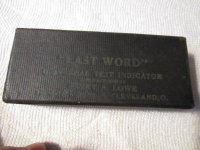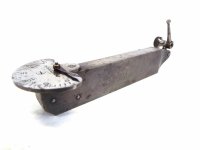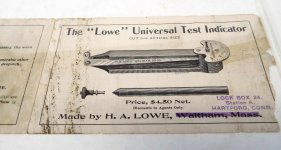rivett608
Diamond
- Joined
- Oct 25, 2002
- Location
- Kansas City, Mo.
This is the 1st type “LAST WORD” test indicator which has been a mainstay in machinist’s tool chests for over a 100 years. For those not familiar with how they work a test indicator measures movement to a thousandth of an inch or finer. It is used to center work in lathe and to locate an edge or hole on a milling machine among other things.
Henry A. Lowe of Waltham, MA. came out with this Universal Test Indicator in 1902. While it looked like his later indicators it was a WHOPPING 6 1/2” LONG. By 1907 he moved to Cleveland, OH. and shortly after started making the modern version we know today shown for comparison, its only 2 1/2” long. The scale on the back was replaced with a crystal covered dial. Lowe stamped his 1902 indicator “Patents Pending” but for some reason it took years before he was issued his first of 3 indicator patents on June 29 1915 (#1,144,367). The L. S. Starrett Co. bought the H.A. Lowe company in 1935 and still produce the famous “Last Word” indicators.
Nearly 120 year ago Lowe wrote “No modern mechanic who TAKES PRIDE IN HIS ABILITY and expects to keep up with the procession can afford to be without this LATEST, NEATEST, MOST VALUABLE AND UNIVERSALLY USEFUL OF ALL mechanics tools. It is bound to become the MOST VALUED accessory of EVERY TOP NOTCHER’S KIT. Its moderate price places it within the reach of EVERY INDUSTRIOUS MECHANIC and he gets MORE ACTUAL USE AND VALUE out of his investment than from any other tool in his collection.”
A note about this quote, Lowe used a bold typeface where I have used all caps, he also used the term mechanic to describe what we now call a machinist. For all his insights into how useful his indicator would be in the future it seems it never occurred to him it might someday be used by women.
I should add these are pretty rare, it took me over 35 years to find one for my collection. A few weeks ago it showed up on one of many ebay searches I check each morning. I was barely awake and saw the picture on the listing and hit buy it now before even reading a word. I then turned over and told my sweetheart “Omg, an early Lowe indicator just sold on ebay” and she said “how did you miss it?” And I replied “I didn’t, I just bought it”. Then I read the read the description.
Henry A. Lowe of Waltham, MA. came out with this Universal Test Indicator in 1902. While it looked like his later indicators it was a WHOPPING 6 1/2” LONG. By 1907 he moved to Cleveland, OH. and shortly after started making the modern version we know today shown for comparison, its only 2 1/2” long. The scale on the back was replaced with a crystal covered dial. Lowe stamped his 1902 indicator “Patents Pending” but for some reason it took years before he was issued his first of 3 indicator patents on June 29 1915 (#1,144,367). The L. S. Starrett Co. bought the H.A. Lowe company in 1935 and still produce the famous “Last Word” indicators.
Nearly 120 year ago Lowe wrote “No modern mechanic who TAKES PRIDE IN HIS ABILITY and expects to keep up with the procession can afford to be without this LATEST, NEATEST, MOST VALUABLE AND UNIVERSALLY USEFUL OF ALL mechanics tools. It is bound to become the MOST VALUED accessory of EVERY TOP NOTCHER’S KIT. Its moderate price places it within the reach of EVERY INDUSTRIOUS MECHANIC and he gets MORE ACTUAL USE AND VALUE out of his investment than from any other tool in his collection.”
A note about this quote, Lowe used a bold typeface where I have used all caps, he also used the term mechanic to describe what we now call a machinist. For all his insights into how useful his indicator would be in the future it seems it never occurred to him it might someday be used by women.
I should add these are pretty rare, it took me over 35 years to find one for my collection. A few weeks ago it showed up on one of many ebay searches I check each morning. I was barely awake and saw the picture on the listing and hit buy it now before even reading a word. I then turned over and told my sweetheart “Omg, an early Lowe indicator just sold on ebay” and she said “how did you miss it?” And I replied “I didn’t, I just bought it”. Then I read the read the description.










